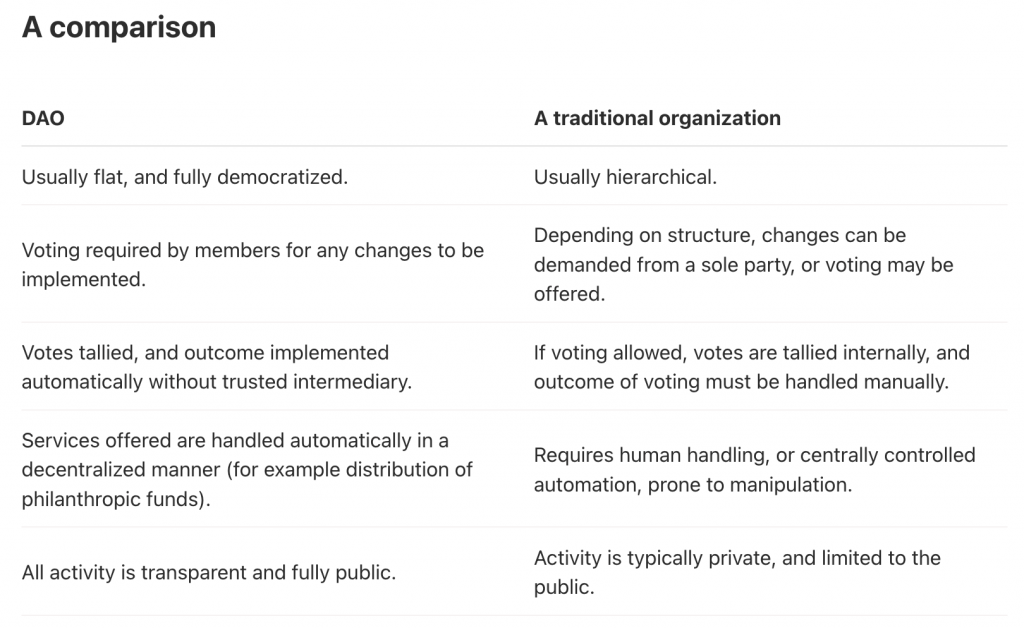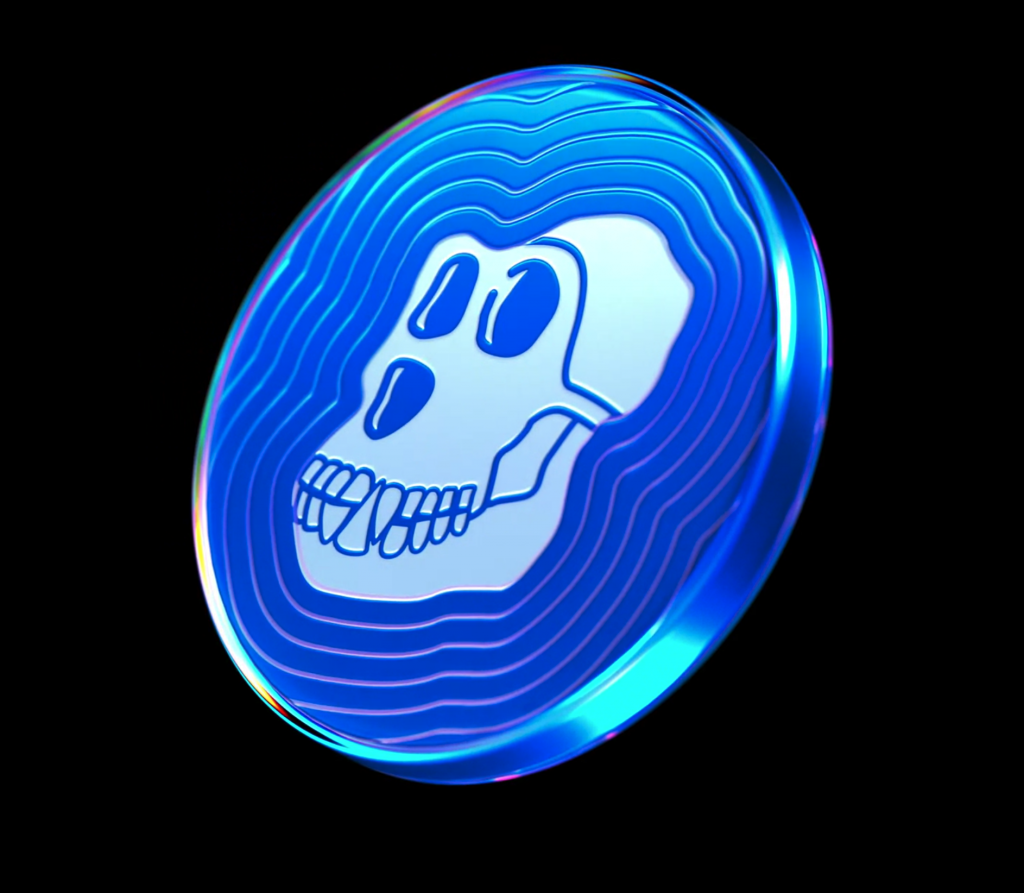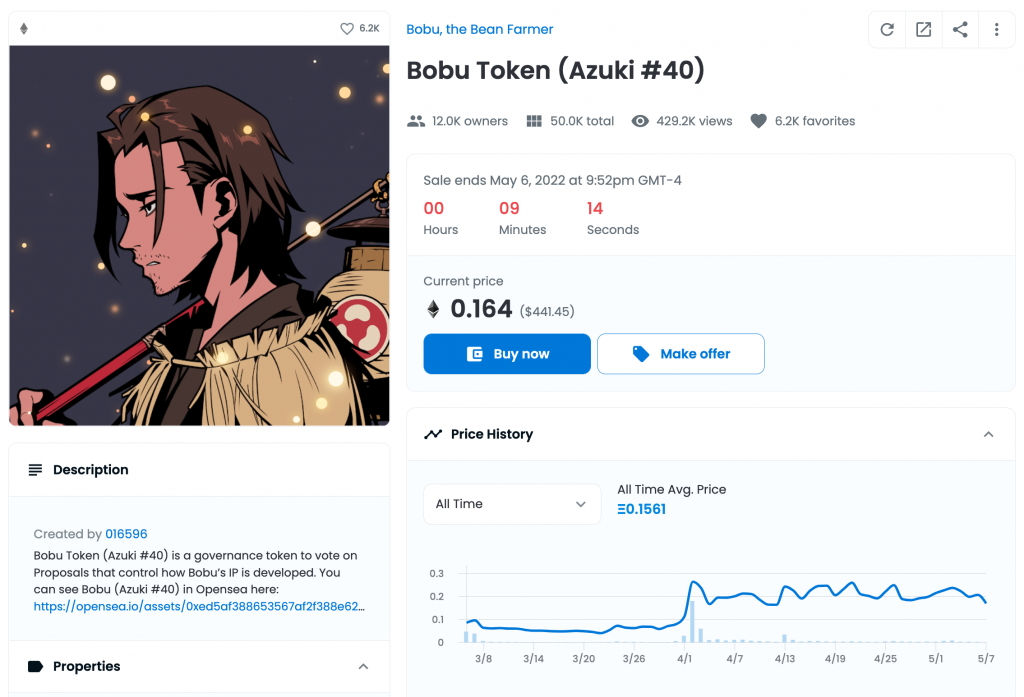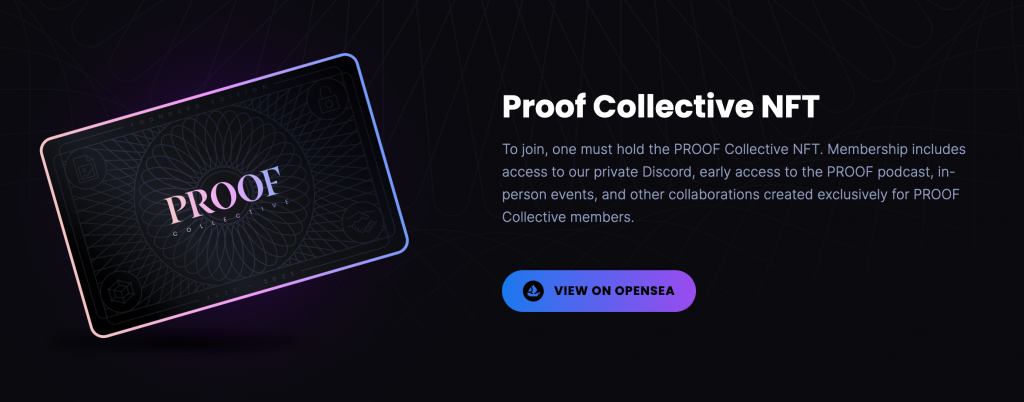Intro:
Over the past year, there has been a craze over Web3 – while terms like blockchain, cryptocurrency, and NFTs have started to become more commonplace, there is still a deeper rabbit hole of other innovative concepts. In particular, this article will focus on DAOs – specifically, what they are, how they function, how they are currently being implemented, and what the future holds.
First and foremost – what are DAOs? DAO stands for decentralized autonomous organization, and at glance, they are an internet-native group of like-minded individuals that are collectively owned and managed by its members. Generally speaking, they have built-in treasuries that are only accessible by group approval and decisions are governed by voting procedures and proposals.
Before diving a little further into DAOs, it is important to have a basic understanding of smart contracts. At a high level, smart contracts “are computer programs stored on the blockchain that allows us to convert traditional contracts into digital parallels… they behave exactly as programmed and cannot be changed”. This is important because it allows for the creation of a digital marketplace built on automatic, cryptographically secure processes that are stored online transparently. This means that a smart contract will execute on its own when the terms are met, allowing for outcomes to be easily predictable, safe and publicly available.
So what do smart contracts have anything to do with DAOs? In order for a DAO to function, it must be governed by a set of rules that every member abides to – in this case, it is the smart contract. Usually, the contract also includes the definition of their treasury, such that all transactions must be approved by the group, without a central authority (thus, decentralized). Additionally, it ensures that payments are automatically authorized when a vote passes. Finally, since the smart contract is placed on the Ethereum blockchain, it cannot be changed or tampered with by any individual. Below, is a chart that compares DAOs to a traditional organization, provided by Ethereum.org

Although this provides a brief overview of DAOs and what the purpose of the structure is, perhaps the easiest way to gain a better understanding of how they function is to explore case studies of how DAOs are being used today.
Case Studies:
First and foremost, we’ll take a look at dOrg, one of the first DAOs to be legally recognized as a LLC within the United States. Within an article detailed by TIME, several members of the DAO spoke to how their company differs from traditional LLCs. First and foremost, co-founder Ori Shimony describes that there are no general management positions (e.g. CEO, CFO) and roles are fluid, such that individuals have different jobs dependent on the project they are currently working on. Additionally, everyone who officially works at the company owns a share of its LLC and all company decisions are made based off of a voting procedure using tokens, which are given to members as they complete projects. While this may sound atypical and off-putting, members within the team explain that for the first time they have real ownership over their work, and the non-hierarchical structure of the company allows for specialists to take on leadership positions when the project requires it, allowing for multiple people to provide guidance and direction. Additionally, since DAOs function remotely, it allows for team members to have more autonomy over their work schedules and hours. Finally, dOrg is also transparent with their salaries with “all salaries and budgeting are publicly maintained on the blockchain; payout logs are visible to each member”, and each member has the option of being paid in cash or tokens. This is probably the gold standard of what Web3 enthusiasts envision DAOs to be and how they can disrupt traditional company structures.
Having said that however, DAOs can vary in many shapes and forms – what is definitively a DAO can be very confusing and its legality can also be called into question. Perhaps one of the most popular DAOs today is ApeCoin DAO. With the recent release of the Otherside NFT that exclusively accepted $APE, we saw prices skyrocket all the way to an all time high of $26 with a market cap of almost 7 billion dollars. The DAO’s membership is simple – holding any ApeCoin provides membership in the DAO, which allows for participating in idea and proposal submissions in addition to voting rights. While we haven’t explored DAOs that are based on tokenomics, this is something that is commonly seen with Web3. Details regarding the governance of the DAO along with proposal processes and voting mechanisms are described in higher detail on their website. More importantly however, is understanding some of the mechanics that make ApeCoin DAO different to other DAOs. First and foremost, 62% of the ApeCoin fund was distributed to holders of the BAYC/MAYC NFTs. Secondly, ApeCoin is tradable on Coinbase, FTX, along with a variety of other large exchanges, despite not being legally registered with the SEC. And finally, the APE foundation, led by Alexis Ohanian (Co-founder of Reddit), is a legal entity that “administers the decisions of ApeCoin DAO”. These differences have caused some to raise eyebrows surrounding the DAO. Under the guise of tokenomics and a DAO, $APE is not a security, despite having “stock vibes“, the DAO never promises profit to holders and states that “One APE equals one APE” and acts as a utility token as in-game currency for Animoca Brands’ Benji Bananas. While this may cause some to be concerned, SEC regulator William Hinman explained in 2018 that if something is “sufficiently decentralized,” it may not be considered a security. Having said that, ApeCoin DAO is comparatively very centralized – not only does it have a foundation that serves as the administrators for the DAO, but BAYC/MAYC creators, Yuga Labs, have a heavy hand in shaping the utility of the token. This unique study gives interesting insight into how legality plays a role into this new organizational structure, along with some of the current flaws in the system that allows for gray areas.

Since DAOs are still relatively new and in the process of being defined, many have already started to explore implementing DAO-like structures into their projects through NFTs.
Perhaps the most notable example is Bobu the Bean Farmer. The “experiment’ explores decentralized IP management, and rather than using a custom smart contract just for a DAO, they operate by creating a tool used for decentralized voting through ERC-1155 tokens (a type of smart contract token used for NFTs). The project operates under many of the same guises and systems seen across many other DAOs, including a governance model that utilizes a multisig wallet that will require multiple members to sign off on transactions, proposals that require governance voting, and a committee that will decide which proposals will be voted on. While many of the core concepts are not original to Bobu, it is the only one that is doing so through an NFT and characterizes members through holders of the Bobu NFT token. Additionally, rather than having a smart contract that onlines voting procedures, currently, votes are held on Discord, which is far from being a decentralized system. Additionally, the Azuki team (the creators behind Bobu as well as the extremely popular Azuki collection) has the power to intervene on Proposals, as well as will be releasing a timeline, schedule and planning the general direction of the project. Although the project itself never identifies as a true DAO, it is interesting to see how NFT projects are taking these concepts and applying them to different areas within the Web3 space.

Another atypical example of a “DAO” is Proof Collective. Having recently launched their Moonbirds collection, they have been receiving a lot of press giving their extreme demand in the secondary market that has racked up over $281 million. While not officially labeled as a DAO, Proof Collective is a group of 1000 NFT collectors, and includes well known figures in the space, including Mike Winkelmann (or Beeple) and Gary Vaynerchuk. Although they are not governed by smart contract, membership to the organization can be bought through owning a Proof Collective membership pass, which originally sold for 1.99 ETH and currently resells for ~100 ETH. Additionally, members are given access to exclusive drops from the brand as well as early access to future releases. Having said that, these are features commonly found within other NFT projects.

The Future:
After studying a couple of examples of DAOs, it is possible that you may feel even more confused than before – unfortunately, given how new all of Web3 and blockchain technology is, this is the reality of the situation. Although many are enthusiastic about the potential of DAOs, such as this Harvard Business Review that echoes many of the points made by dOrg members – notably that DAOs allow for individuals to have more autonomy over where, when and how they work, more freedom to pursue more fulfilling projects, more decision-making power, ownership and transparency with compensation – there is also a lot of uncertainty with how these organizations will operate legally as well as the direction and future of how they function. Whether or not they continue to operate using more traditional tokenomics or NFTs is still yet to be seen and the line between what is considered a DAO and what is not is still currently being built and developed as we watch the world of Web3 continue to grow.
Bibliography
- “Apecoin.” ApeCoin, https://apecoin.com/.
- “Azuki.” Bobu The Bean Farmer, https://bobu.azuki.com/governance.
- Chow, Andrew R. “No Bosses: What It’s like Working at a Dao.” Time, Time, 24 Mar. 2022, https://time.com/6146406/working-at-dao-dorg/.
- “Decentralized Autonomous Organizations (Daos).” Ethereum.org, https://ethereum.org/en/dao/.
- “Ethereum’s Russian-Born Cofounder Has Been Quietly Supporting a Dao That Raised $8 Million in Crypto for Ukraine. His Dad Is Even More Involved.” Yahoo! Finance, Yahoo!, https://finance.yahoo.com/news/ethereum-russian-born-cofounder-quietly-183929743.html.
- Glaveski, Steve. “How Daos Could Change the Way We Work.” Harvard Business Review, 7 Apr. 2022, https://hbr.org/2022/04/how-daos-could-change-the-way-we-work.
- Locke, Taylor. “Russian-Born Ethereum Co-Founder Vitalik Buterin Quietly Donates $5 Million to Ukraine Relief Efforts.” Fortune, Fortune, 8 Apr. 2022, https://fortune.com/2022/04/08/vitalik-buterin-ukraine-donation-ethereum-russian-invasion/.
- Locke, Taylor. “What Is the Moonbird NFT Collection, and Why Did It Surge so Quickly?” Fortune, Fortune, 19 Apr. 2022, https://fortune.com/2022/04/18/moonbird-nft-collection-surge/.
- Lopatto, Elizabeth. “Will APECOIN and Yuga Labs Make the Regulators Go Ape?” The Verge, The Verge, 25 Mar. 2022, https://www.theverge.com/2022/3/25/22994795/apecoin-yuga-labs-sec-regulation-utility-token.
- Roose, Kevin. “What Are Daos?” The New York Times, The New York Times, 18 Mar. 2022,
https://www.nytimes.com/interactive/2022/03/18/technology/what-are-daos.html. - “Smart Contracts.” Ethereum.org, https://ethereum.org/en/smart-contracts/.
- Stevens, Robert. “What Is Tokenomics and Why Is It Important?” CoinDesk Latest Headlines RSS, CoinDesk, 11 Apr. 2022, https://www.coindesk.com/learn/what-is-tokenomics-and-why-is-it-important/.
- Tan, Eli. “YouTuber Logan Paul Files Trademarks for NFT Marketplace, Dao Ventures.” CoinDesk Latest Headlines RSS, CoinDesk, 10 Feb. 2022, https://www.coindesk.com/business/2022/02/10/youtuber-logan-paul-files-trademarks-for-nft-marketplace-dao-ventures/.